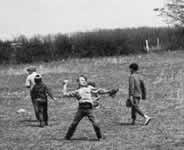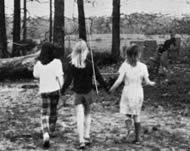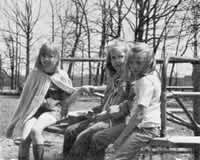 |
Volume I, No. 1, Fall 1973 |
Children's Games
In our interviews, it seemed to us that the children that liked the rural schools the most were ones who had first attended school in a larger system. We think that one of the reasons for this is the fun they had at recess. At recess the children played many games. We have tried to bring you a few of them.
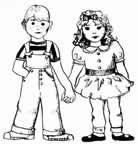
The games played in the rural schools differed from those played in other schools because of the age variation of the children, the lack of playground equipment, and the isolation of the schools. The children's ages ranged from five to sixteen. The schools were usually small, so students of all ages played with one another. Playground equipment usually consisted of balls, bats and swings, with some merry-go-rounds and teeter-totters. So children played games like red light, crack the whip and three deep that required no equipment, or others like steal sticks, kick the can and geography contest which used things found around the school like twigs, old cans and even school books. Since the children were all out at recess at the same time, they did not have to worry about disturbing other classes. Because of this and the two to five acres of land around the school, the children were free to yell and run as much as they wanted. These three things helped them work together, use their imagination and learn responsibility. The playground situation made the children become more independent and taught the older children to watch out for the younger ones.
Of course, the children of the rural schools played many of the same games all children play, such as tag, hide and seek and drop the hanky. But these games as in all games played at the one-room schools had many versions and variations. If you've ever watched children play, you know that they change the rules in the middle of the games to suit themselves. So in the following games, make your own rules, if you don't like ours.
The all-time favorite game was baseball. But sometimes there were not enough players for two teams, so the children played a game called work-up.
[40]
Work-up uses about the same rules as baseball, only there are not two teams. Any number from seven up can play. The batter tries to stay up at bat as long as he can without making an out. When he makes an out, he goes to right field and the catcher is the new batter. All the other players rotate one position. (See diagram.) If there are not enough players For every position, players space themselves over the playing field to cover it. Newcomers can join the game at any time by going into last field. If someone drops out, the other players simply move up or spread out to cover his position. The game is Fun, without the restrictions and pressure of organized teams.
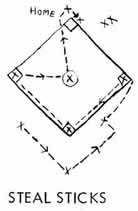
To get to the sticks, players have to cross into enemy territory where they could be tagged. If tagged they must go into the jail to stay until freed by being touched by a fellow team member. He still must successfully reach home territory without being caught. Once any player crosses the line, he may be tagged and imprisoned. Runners must stay within base line of the ball diamond.
If the player trying to steal a stick succeeds and regains his home ground without being tagged, he adds that stick to his team's pile. He can steal only one stick at a time.
The player that is "it" stands in front of the base, while the others line up facing him about 100 Feet away. When "it" turns his back and says, "Green Light," the players try to get as close to the base as they can. When "it" Faces the other players, he says, "Red light." All the players must stop where they are. If they move they must go back to the start. The First player to reach base is the new "it." Crafty players can move closer to base line without "it" catching them.
Mother, May I? is a variation of red light. One player is the mother or "it." The mother stands in front of the base about 100 Feet from the starting line. The mother gives a command like, "Suzie, take Four giant steps." Suzie must ask, "Mother, may I?" Mother could answer yes or no. If the answer is yes the player follows the command. If the player forgets to ask, "Mother, may I?", he has to go back to the starting line. While mother was not looking players could sneak up, but if caught, they must return to the starting line. Some of the commands mother might give are-baby steps, giant steps, duck steps (squat and walk), alligator steps (lie down and stretch arms out as Far as can reach). The steps vary and are sometimes original.
A variation of this game and red light would be for the ones who successfully reached base to go hide. When everyone reaches baser the game becomes a hide and seek game.
[41]
The players form two teams on opposite sides of the field and hold hands very tightly. Teams take turns saying,
Red Rover, Red Rover, Send right over. On hearing his name the player runs to the other side and tries to break through the hold of the other players. If he is successful, he takes a player back to his team, but if he fails, he must stay on that side. The team wins that gets all the members of the other team. This often leaves players with bruised or sore arms and wrists.
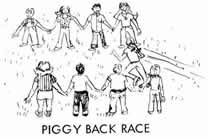
Choose up in groups of two, one is the piggy, and the other is the rider. On the signal go, the rider hops on the piggy's back. The first twosome across the finish line wins.
A blindfolded player stands within the moving circle of players. When he claps his hands three times, the circle must stop. He then points to one member of the circle. The player painted to must come into the middle of the circle to be chased until caught. When caught, the blind man feels the player's face and tries to guess who he is. If he fails, he must try again. If he succeeds, the player caught becomes the blind man.
Find a high place like a pond bank, a cellular or hill. The player to be the King gets on the high place and the other players try to push him off. The person that succeeds is the new King.
Draw a line in the dirt in a field and get a rope. Number off the same amount on each side of the rope. Staff pulling. The first team that gets the other team across their side of the line wins.
Sometimes the games get quite rough as the next three show.
Everybody holds hands in a line. The first one in line is the leader. The whole line starts running. The leader stops and swings the others around. The player on the end gets all the rough stuff. Players just keep on doing this, changing leaders each time. The longer the line of players, the harder the one on the end gets swung.
Form two equal circles, one inside of the other with one player in front of another all facing inside. Two players, the chaser and the runner, are outside the circle. The runner may weave in and out of the circle, with the chaser pursuing him. When he chooses to, the runner may stop in front of a player in the inner circle causing the second player directly behind him to be the runner. If the chaser tags the runner, they change places. This is a very fast moving game and all players must be alert, for they may become the runner at any time.
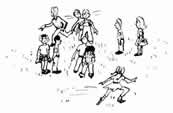
[42]
This game needs a building large enough to hide a group of people and small
enough to throw a ball over. The schools were excellent for this. The only other equipment
needed is a ball, preferably not a hard ball because of the danger of breaking windows. The
players divide into two teams on either side of the building. Team I throws the ball over the
building yelling, "Anti-over." Team II tries to catch the ball before it hits the ground. If someone
succeeds in catching it, they all sneak around the building while the player who caught the ball
tries to touch as many players from Team I with the ball as he can, before they reach the safety of
the half way mark. Players tagged join Team II. In this way teams change sides each time the ball
is successfully caught.
If Team II did not catch the ball, some player must return it the same way he received it. The team
that captures all the players wins.
There are lots of tricks experienced players use to outwit the other side. There are techniques in
throwing the ball so the other team can't catch it. There are strategies for slipping around the
building and catching the other team unaware, for teams never know whether the ball 'has been
caught until they see the other team come around the building or hear the call, "Anti-over." They
also don't know who has the ball for only he can capture players.
This game is played in the snow in a maze the children trample out. (See diagram.) One player is the fox. He chases the rest of the players. Everyone must stay in the paths. When he fox catches one of the geese, he puts him in the middle of the maze in the pen. The game is over when all the geese are in the pen.
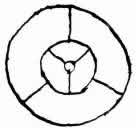
This game is also played in the snow. One player is the fox and the others are the hounds. The fox makes a trail in the snow. The hounds must follow it to catch the fox. When he is caught he becomes a hound and another player the fox. The new fox can make another trail.
Players form a circle with hands clasped. One player is the cat, another the mouse. The mouse runs around the circle chased by the cat. The other players keep their hands clasped and, at any time, will raise them to let the mouse dodge in or out, but they .try to prevent the cat from getting through. When the mouse is caught, he chooses another player to be the next cat. The former cat becomes the mouse.
This game begins like hide and seek. Everyone hides. "It" looks for the other players. When he finds them, they must stay in a square marked in the dirt. This game needs an old can near the base. If a player who is not caught can sneak up to the can and kick it without "it" seeing him, all the players may run hide again. "It" returns the can to its position and starts over. The players have only enough time to hide as it takes "it" to return the can to its position; therefore, the players try to kick the can as far as they can. Usually this game is long and unless "it" is very experienced, he has difficulty catching everyone.
[43]
The children of the rural school usually spent their recesses outside. But sometimes because of bad weather they would be forced to stay inside. So here are some indoor games they played.
The group divides into teams. One team gives the name of a town, a river, or mountain, etc. for the other team to tell what state, county or country, etc., that it is located in. If right their team gets a point. Then they ask the next question. Sometimes the teacher asks the question.
Along with having fun the children learn in this game.
Rocks or grains of corn are divided so each player has an equal number. The person who first says, "Hull gull," to another person takes the lead. Player II says, "Hands full." Player I holds up his fist with the corn, etc., in it says, "How many?" Player II guesses. If he guesses right, Player I gives him all in his hand. If he guesses wrong, he gives Player I the difference. For instance, if Player I had six and Player II guessed four, he had to give Player I two grains. The few who collect all the corn are the winners.
This is a good game to keep little children quiet.
One person hides a thimble and the others come in to look for it. The first one that sees it says, "1 spy," but he doesn't show anyone where it is until everyone finds it. The first one that finds it gets to hide it next time. If it is hard to find, sometimes the one who hides it will give clues, such as, "You're getting warm," or "You're getting cold."
Seven children stand in the front of the classroom. One of them is the leader. When the leader says, "Heads down, thumbs up," the children in their seats lay their head down on their desks and put their fists on their desks with thumbs up. The seven children in the front of the room each touch one person's thumb. After they have done this, they go back to the front. Then the leader says, "Heads up, stand up." The children that have been touched guess once who touched them. If they guess right, they take that person's place. If they don't guess right, they lay their heads down again as the game continues.
[44]
Copyright © 1981 BITTERSWEET, INC.
Next Article | Table of Contents | Other Issues
